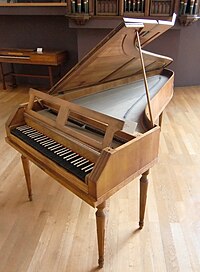The Piano Concerto No. 18 in B♭ major, K. 456, is a piano concerto by Wolfgang Amadeus Mozart. In Mozart's own catalogue of his works, this concerto is dated 30 September 1784.[1]
| Piano Concerto in B♭ major | |
|---|---|
| No. 18 | |
| by W. A. Mozart | |
 Pianoforte by Johann Andreas Stein (Augsburg, 1775) – Berlin, Musikinstrumenten-Museum | |
| Key | B♭ major |
| Catalogue | K 456 |
| Composed | 1784 |
| Movements | Allegro vivace Andante Allegro vivace |
| Scoring |
|
History
editFor years, historical speculation was that Mozart had written this concerto for Maria Theresia von Paradis, based on a letter written around that time by Leopold Mozart to his daughter Nannerl. However, Hermann Ullrich has discounted this theory, based on the date of entry in Mozart's catalogue and the fact that von Paradis had left Paris at the start of October 1784, which indicated that there was not sufficient time to send her the concerto for performance.[1] Richard Maunder has countered with the idea that Mozart could still have sent the concerto to Paris and that it would have been forwarded to von Paradis in London, where it was possible that she performed the work in March 1785.[2]
Music
editThe work is orchestrated for solo piano, flute, two oboes, two bassoons, two horns (in B♭, second movement in G), and strings. Its movements are:
The slow movement is a theme and variations. Martha Kingdon Ward has commented that the slow movement of this concerto contains one of the "most tranquil" of Mozart's flute solos, specifically in the G-major variation.[3]
M. S. Cole has noted Mozart's use of meter changes in the finale, starting at measure 171, from 6
8 to 2
4 in the winds, with the piano following at measure 179. This changing of tempo in rondo finales was contrary to common practice at the time.[4] Joel Galand has performed a Schenkerian analysis of the rondo finale and noted features such as its novel use of ♭II as a remote key.[5] In practical terms, this means that the last movement leaves the home key of B-flat major for an episode in the apparently-unrelated key of B minor and changes metre while maintaining the same beat – a highly unusual procedure in the musical language of the time.
Mozart wrote out two cadenzas for the first movement. Joseph Swain has performed a Schenkerian analysis of each first-movement cadenza.[6]
References
edit- ^ a b Ullrich, Hermann (October 1946). "Maria Theresia Paradis and Mozart". Music & Letters. 27 (4): 224–233. doi:10.1093/ml/XXVII.4.224. JSTOR 727582.
- ^ Maunder, Richard (1991). "J. C. Bach and the Early Piano in London". Journal of the Royal Musical Association. 116 (2): 201–210. doi:10.1093/jrma/116.2.201. JSTOR 766338.
- ^ Ward, Martha Kingdon (1954). "Mozart and the Flute". Music & Letters. 35 (4): 294–308. doi:10.1093/ml/XXXV.4.294. JSTOR 730699.
- ^ Cole, M. S. (1974). "Mozart Rondo Finales with Changes of Meter and Tempo". Studia Musicologica Academiae Scientiarum Hungaricae. 16 (1–4): 25–53. doi:10.2307/901841. JSTOR 901841.
- ^ Galand, Joel (Spring 1995). "Form, Genre, and Style in the Eighteenth-Century Rondo". Music Theory Spectrum. 17 (1): 27–52. doi:10.1525/mts.1995.17.1.02a00020. JSTOR 745763.
- ^ Swain, Joseph P. (1988). "Form and Function of the Classical Cadenza". The Journal of Musicology. 6 (1): 27–59. doi:10.1525/jm.1988.6.1.03a00020. JSTOR 763668.
External links
edit- Konzert in B KV 456: Score and critical report (in German) in the Neue Mozart-Ausgabe
- Piano Concerto No. 18, K. 456 (W. A. Mozart): Scores at the International Music Score Library Project